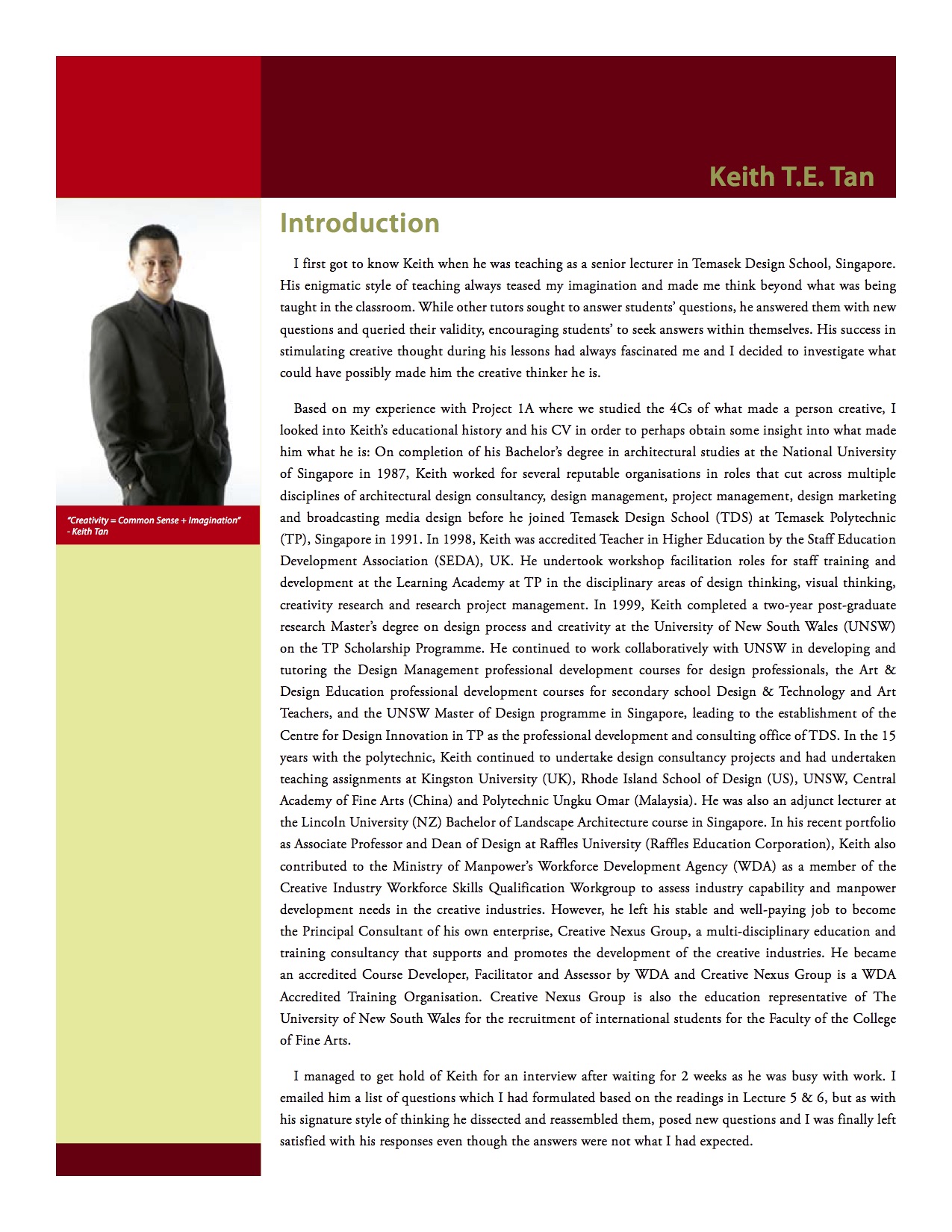|
|
Keith T.E. Tan Master of Design (Honours) - The University of New South Wales Bachelor of Arts (Architectural Studies) – National University of Singapore Teacher in Higher Education accreditation by Staff Education Development Association (SEDA), UK Associate Member of Singapore Institute of Architects Professional Member of Design Business Chamber Singapore Accredited Trainer, Course Developer & Assessor of Singapore Workforce Development Agency (WDA) |
Keith Tan is Founder and Principal Consultant of Creative Nexus Group, a multidisciplinary education, training and consulting enterprise established since 2008 to support and promote the development of creativity, entrepreneurship, design thinking, innovation and lifelong learning across different fields and industries.
Keith brings with him more than 20 years of teaching, training and consulting experience having worked his way up from the commercial sectors into senior academic, training and consulting positions in a diverse range of expertise within various industries. His expertise and experience covers the disciplinary areas of creative thinking, creative problem solving, creative visualisation, design thinking and innovation. His teaching, training and consulting experience is backed by his professional and academic background in the disciplines of Architecture and Design that enable him to think visually, grasp complex ideas and concepts quickly and problem-solve creatively. Keith also works collaboratively with institutes of higher learning to develop and deliver professional development courses on creativity, design thinking and innovation.
Public Talks, Guest Lectures, Conferences and Seminars
Click the titles below for details
DESIGNING INNOVATION: CREATIVE STRATEGIES FOR BUSINESS DESIGN AND INNOVATION
"Stories curate experiences. Design is about infinite possibilities. Design is a mindset of looking at the world with an eye to improve the things we do and the way we do them."
Date & Time
16 October 2014, 9am
Synopsis
Design is a strategic tool in business that creates competitive advantage for business success. This session will examine the creative strategies for business innovation by design and explore the notion of business design in the light of value creation as a catalyst for transformative business change. This includes innovating new products, services, and experiences.
The session will address three key questions:
(1) What is the role of creativity in the business design process?
(2) What are the creative processes that drive business innovation?
(3) What are the innovation principles of product, service and experience design?
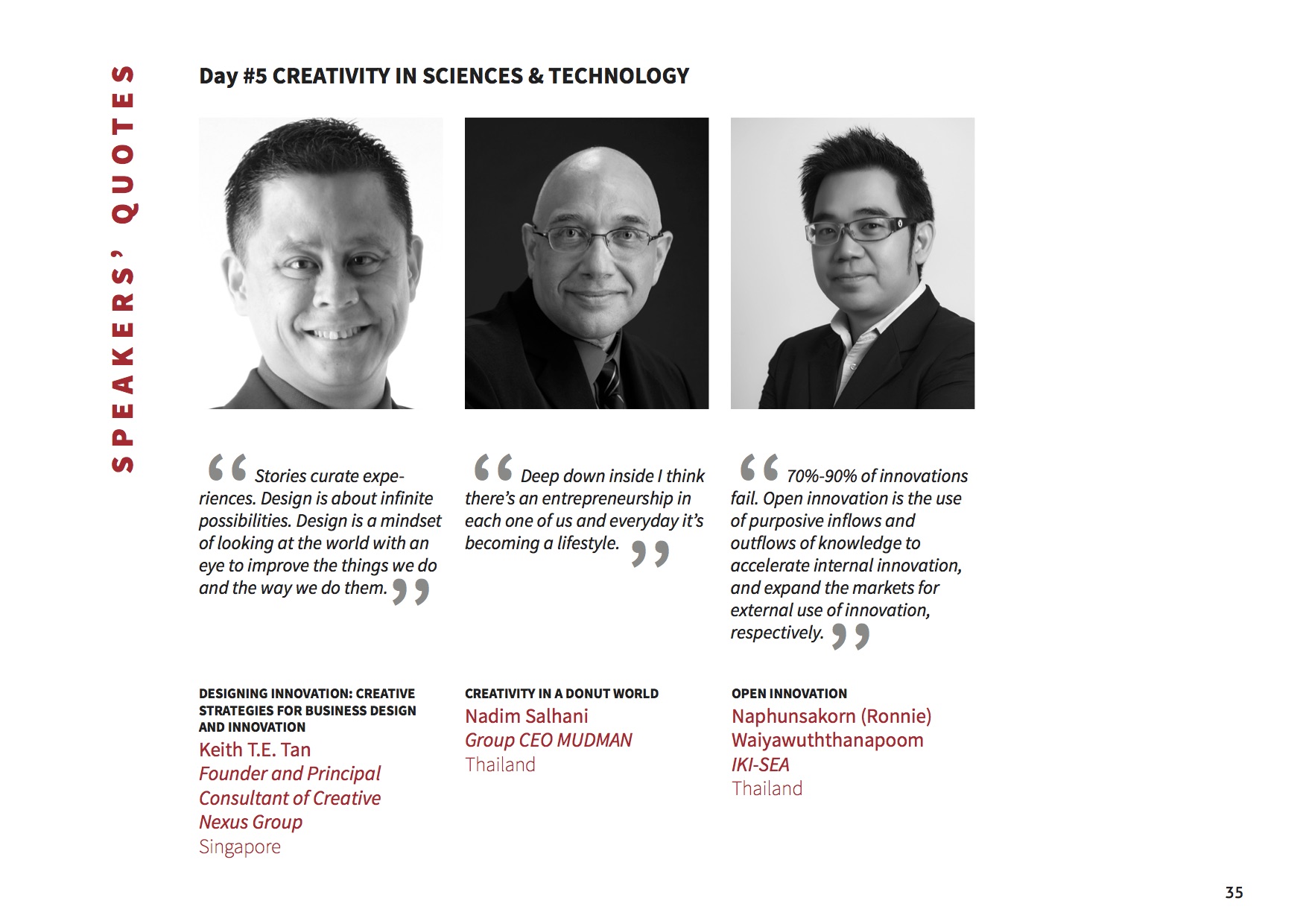
Guest Lecture at Singapore Institute of Technology
Date & Time
6 March 2014, 2pm
Synopsis
Where do ideas come from? What shapes our mind and the way we think? Why do we do what we do? What are the skills of the future and the creative skills needed to prepare ourselves for the future? Why should we be concerned about how to think?
We are defined by what we think and how we think. What we do and how we do what we do reflect the way we think. We operate within a mindset that sets a pattern to our thoughts and actions. Mindsets shape the decisions we make and dictate our abilities to create new possibilities. We “change” our minds often but we hardly change our mindsets. We need to pause and think again about what we do, why we do what we do and how we can do better with better thinking. That is the creative factor for productivity in work and in life. How can we design our mindset for creativity? How can we engage our mind to unleash our creative potential so that we can do less to achieve more?
Lunch Talk at National Community Leadership Institute
Date
6 June 2012
Synopsis
The complex world of today needs a whole new way of thinking about the way we learn, work and play. We need skills that can help us think better, think faster, think differently, and think creatively. This means that a fundamental shift in our thinking behaviour is needed to drive our businesses and our personal lives. We need creativity, design thinking and innovation to put in perspective the value that this shift can bring. In the design thinking paradigm, divergence, empathy, intuition, creativity and holism are the essential traits to create things out of nothing, and to create opportunities when they never existed. How can we trigger the shift in our thinking behaviour and embrace a new way of thinking? How is this important?
Public Talk at NUS Extension
Date & Time
6 October 2011, 4-5pm
Title
The Creative Mindset - Do Less and Think More:
Why less is more and how to do less to achieve more
Synopsis
We are defined by what we think and how we think. What we do and how we do what we do reflect the way we think. We operate within a mindset that sets a pattern to our thoughts and actions. Mindsets shape the decisions we make and dictate our abilities to create new possibilities. We “change” our minds often but we hardly change our mindsets. We need to pause and think again about what we do, why we do what we do and how we can do better with better thinking. That is the creative factor for productivity in work and in life. How can we design our mindset for creativity? How can we engage our mind to unleash our creative potential so that we can do less to achieve more?
Public Talk at NUS Extension
Date & Time
4 July 2011, 3-4pm
Title
Re-think and Re-invent How You Think:
Why it matters less what you know and more how you think
Synopsis
We are creatures of habits. We set patterns and routines to the way we work that do not motivate us to think. To level up to the “cheaper, better and faster” paradigm of the new work environment, we need to re-think and re-invent the way we think so that we are creative and productive. We need ideas to re-invent. We need lots and lots of ideas. We cannot “reduce, re-use and recycle” our way of thinking to generate fresh ideas. We need to think better to re-invent. How do we use our mind more, think better, and think differently so that it matters less what we know and more how we think? How do we re-think and re-invent the way we think to create meaningful experiences for a better way to work?
Guest Lecture at AIA Learning Festival 2011
Dates
14, 15, 16 February 2011
Synopsis
The complex world of today needs a whole new way of thinking about the way we learn, work and play. We need skills that can help us think better, think faster, think differently, and think creatively. This means that a fundamental shift in our thinking behaviour is needed to drive our businesses and our personal lives. We need creativity, design thinking and innovation to put in perspective the value that this shift can bring. How can we trigger this shift and embrace a new way of thinking? How is this important?
Public Talk at NUS Extension
Date & Time
19 November 2010, 3-4pm
Title
Creativity, Design Thinking and Innovation –
What can we do to think better and to create value in what we do?
Synopsis
The complex world of today needs a whole new way of thinking about the way we learn, work and play. We need skills that can help us think better, think faster, think differently, and think creatively. This means that a fundamental shift in our thinking behaviour is needed to drive our businesses and our personal lives. We need creativity, design thinking and innovation to put in perspective the value that this shift can bring. How can we trigger this shift and embrace a new way of thinking? How is this important?
Guest Lecture at LaSalle College of the Arts
Date & Time
2 March 2010, 1-3pm
Synopsis
The making of an interior space begins with a concept for the character of the space. This character defines the quality of the space, also known as ‘spatial quality’. This lecture will review the input of the interior designer in the creation of spatial quality giving rise in particular to the psychological existence of the interior space.
The lecture will explore:
- the essence of space
- the definition of an interior space
- the psychological existence of space
- the role of the interior designer in the design and creation of ‘psychological spaces'
- What it takes to create the psychological dimension of an interior space
Public Lecture at the Singapore Design Festival 2009
ICSID World Design Congress Exhibition
Portfolio Show for Young Designers
Date
26 November 2009
Synopsis
This lecture addresses the skills, knowledge and talent gaps in the design profession that need to be bridged to meet the challenges of the constantly changing design industry. Boundaries of design disciplines must shift constantly as we re-think the meaning of design while keeping up with continuous learning, unlearning and relearning. The lecture will move from establishing the idea of what design is to the notion of how design is multi-dimensional, multi-sensate and multi-disciplinary - that in the process of design and the profession of design practice, the idea of design is broad-based and demands a multi-disciplinary design thinking approach to drive good design outcomes.
Institute for Adult Learning SINGAPORE
ADULT LEARNING SYMPOSIUM 2009
Dates
5, 6 November 2009
Synopsis
Technological advances have brought about irreversible changes to the notion of creativity. The impact of these changes on the creative industry are particularly evident in the new and emerging forms of creative work and the ease at which creative ideas can now be communicated. More importantly, the changes bring forth challenges and opportunities to the way creativity and the creative processes are perceived, bringing about a re-think of their meanings and what these mean to professional competencies and skills training for the creative professional.
This presentation will address the industry trends and demand on the creative professional and the character of the training curricula needed to address them. It will differentiate ‘performance-driven’ training programme from ‘talent-driven’ training programme for the creative industry, and propose a training framework to address them.
Institute for Adult Learning SINGAPORE
ADULT LEARNING SYMPOSIUM 2008
Dates
4, 5 December 2008
Synopsis
The creative industry is home to the talents of the arts, design and media. It is an industry driven by creativity and dominated by people passionate of their skills and crafts – the reflective practitioners.
This presentation will address the professional practice and the direction for professional development in the creative industry. It will explore the underpinning precepts in the training and development of a creative individual; the creative traits of a creative person and the cognitive processes of creativity to articulate the psycho-social influence on creative outcomes. It will then rationalise the nature of training and learning of a creative professional. The presentation also seeks to understand how creative people learn and work in order to establish benchmarks for training, learning and professional development.
Media News and Articles
Click the titles below for details
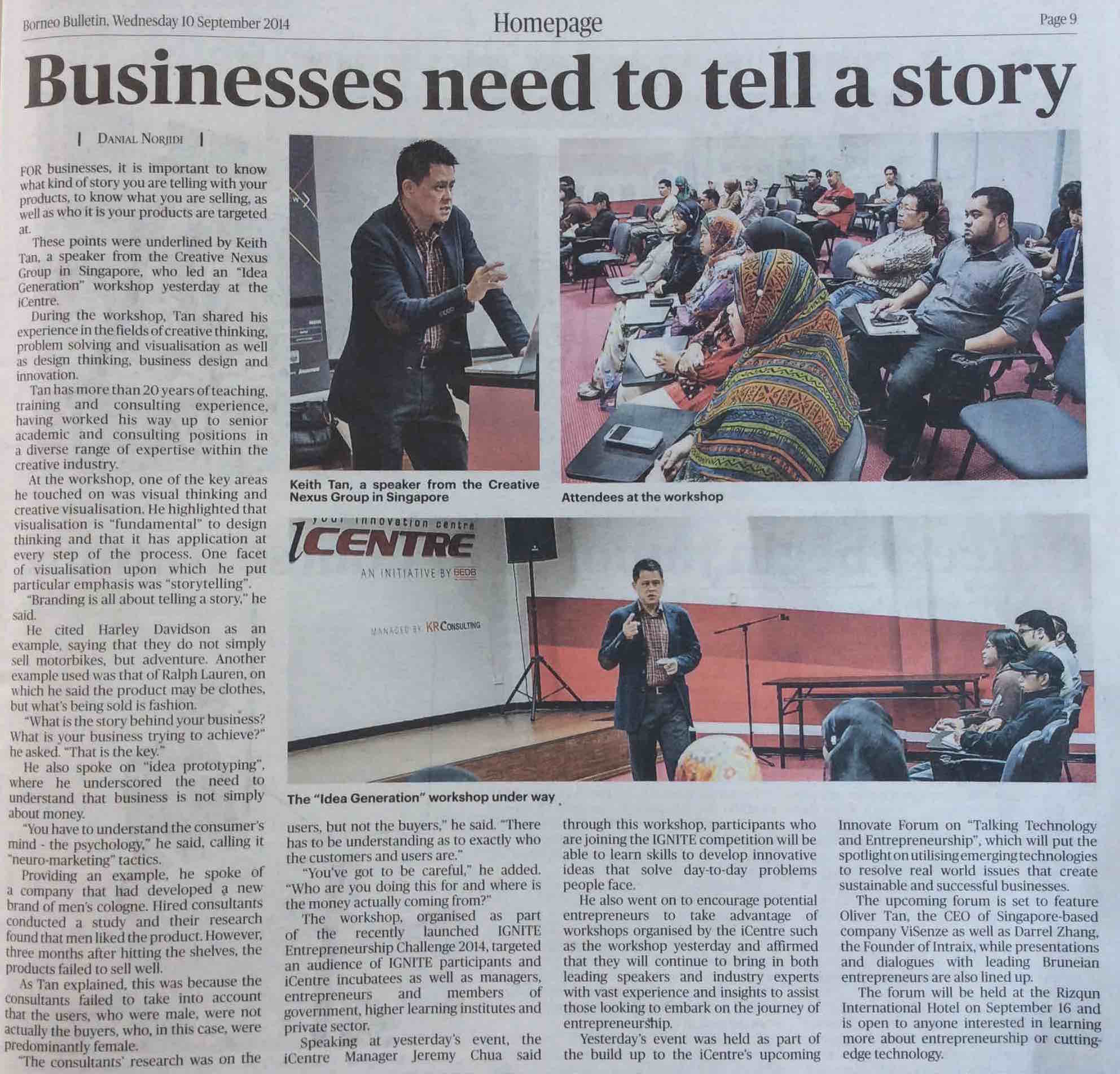
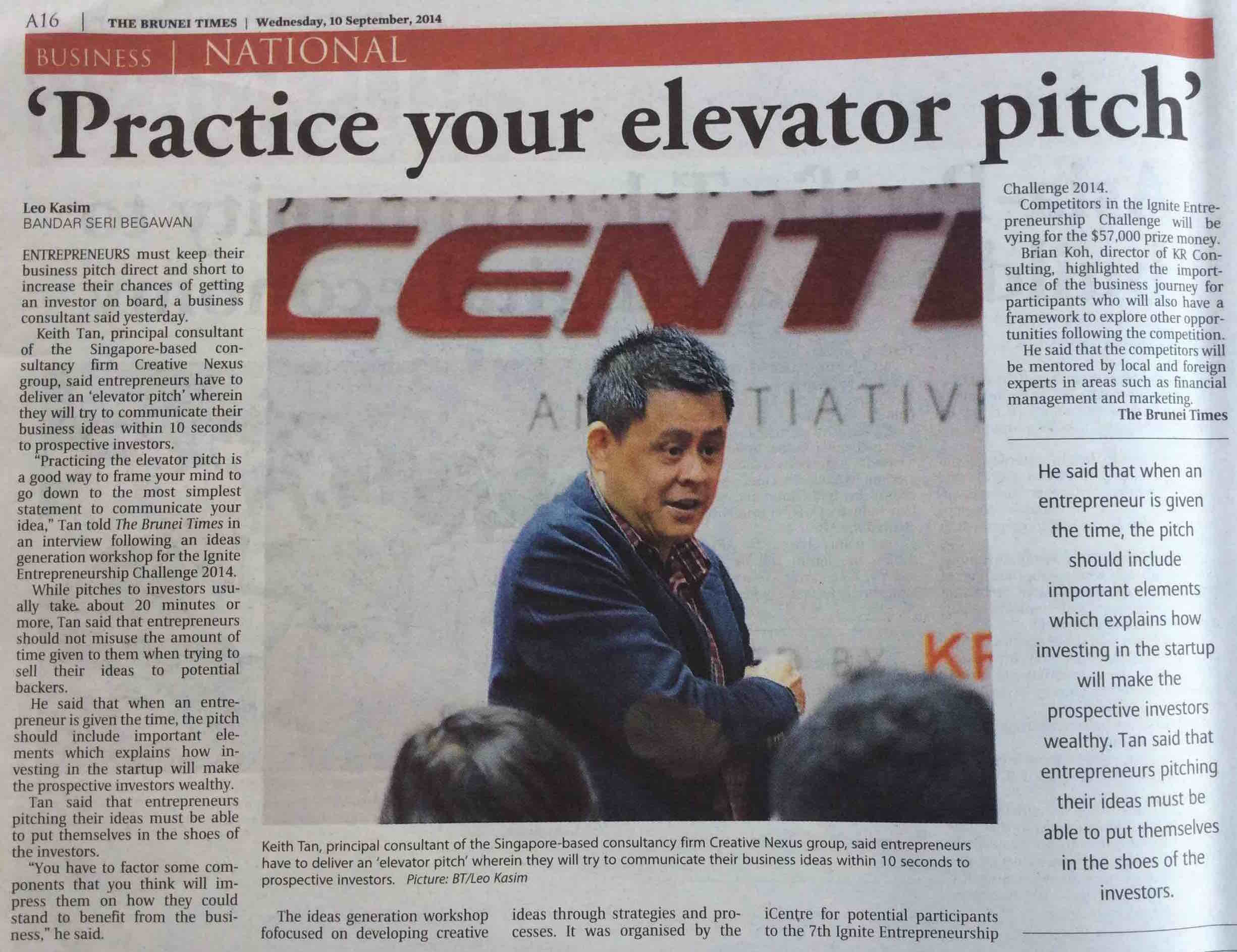
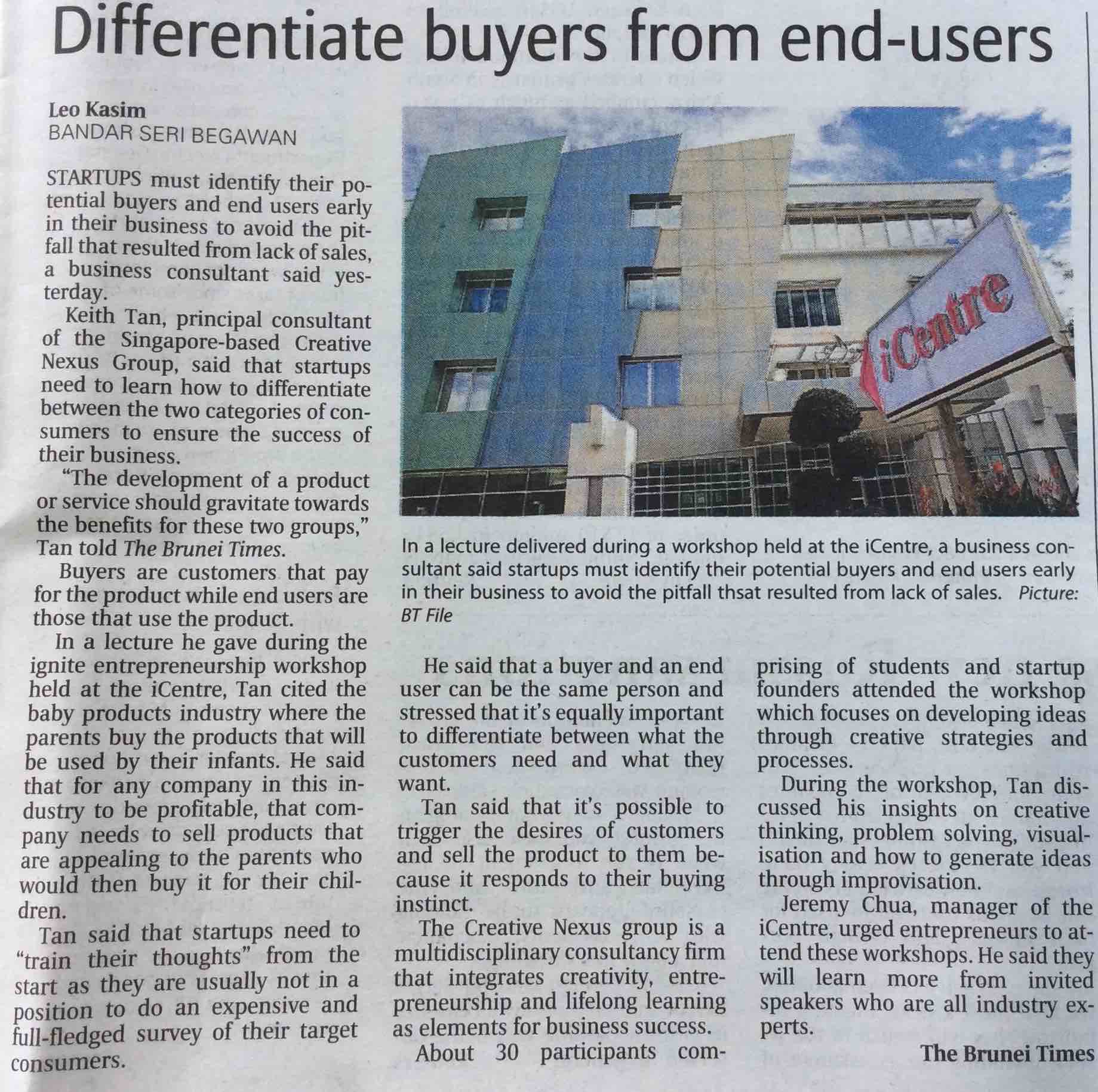
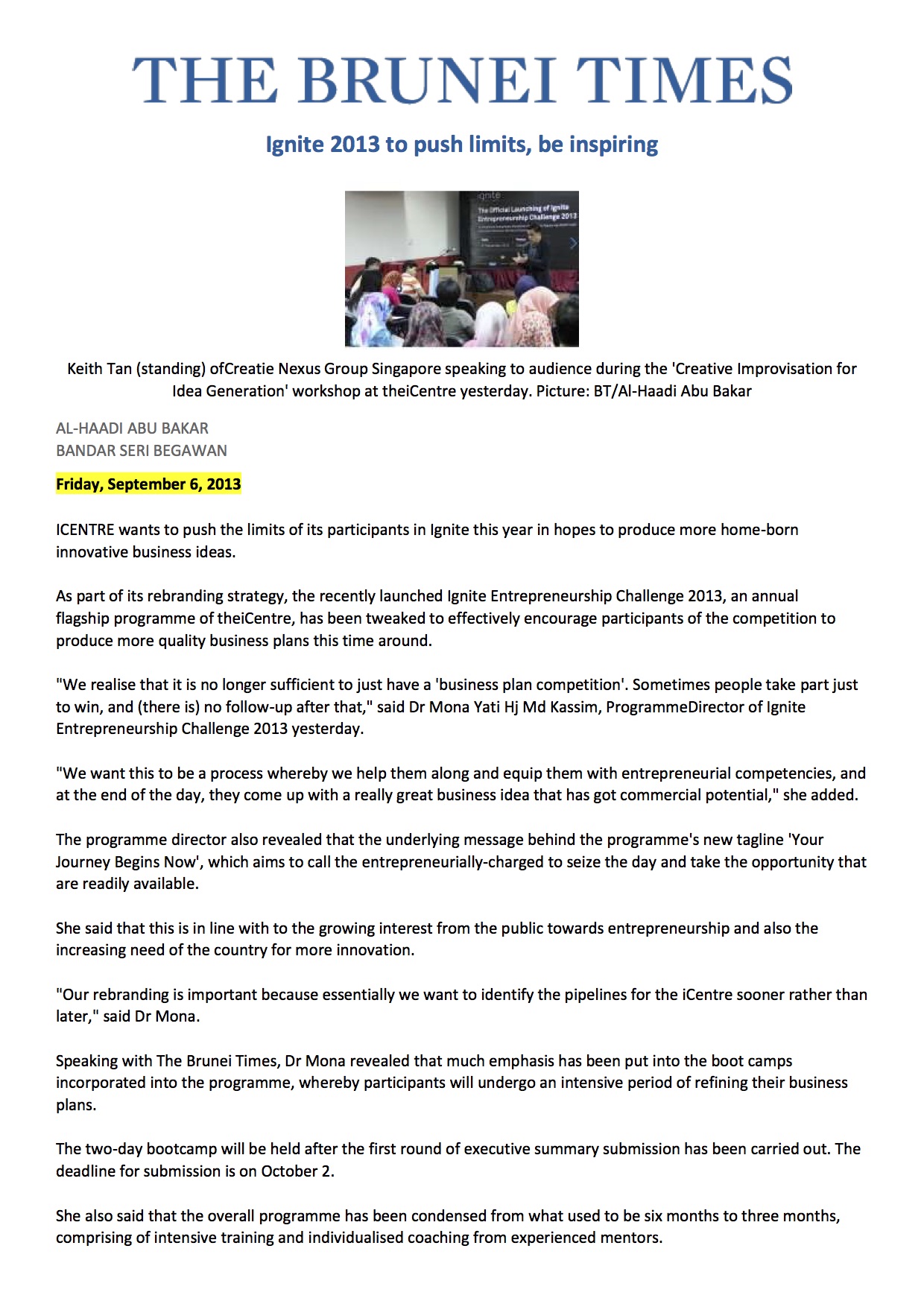
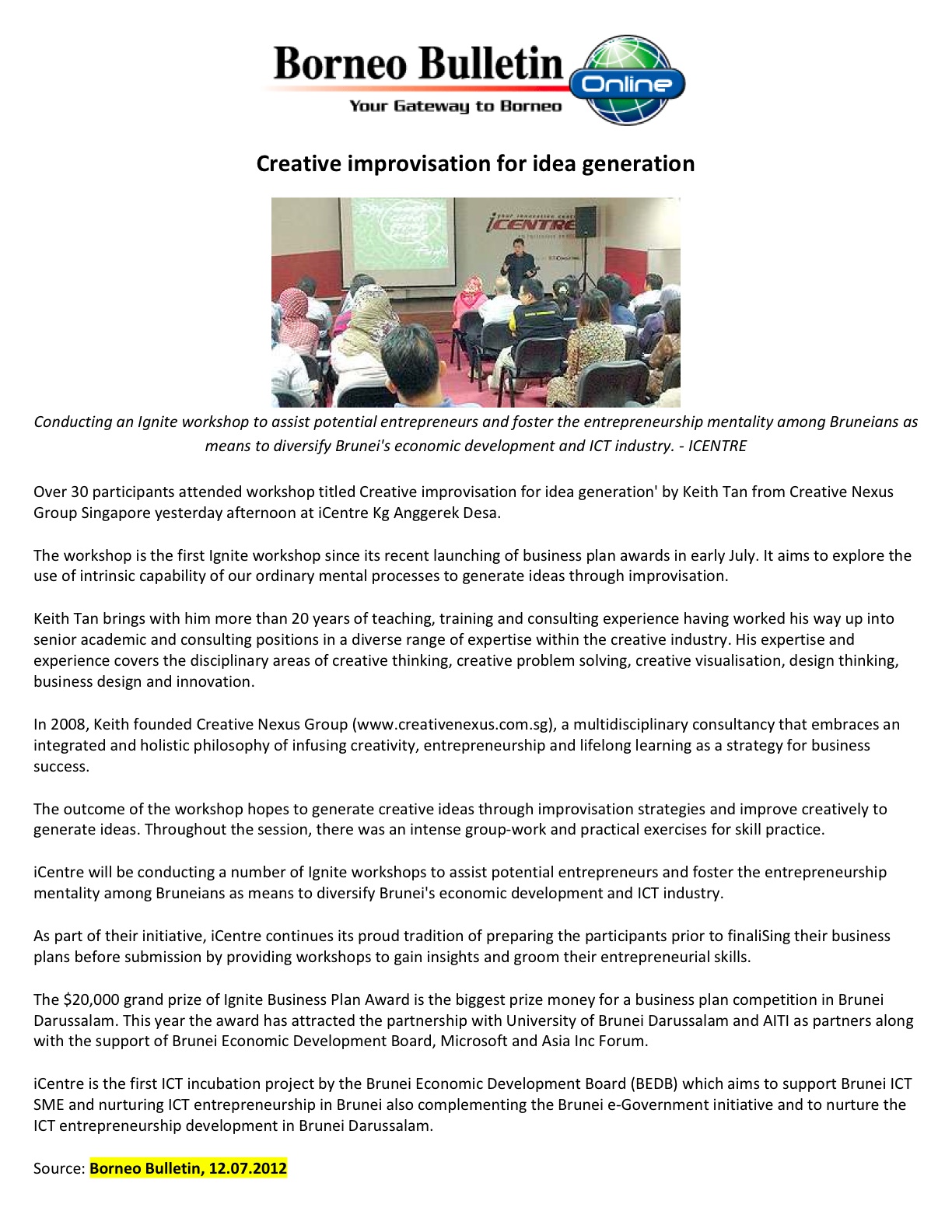
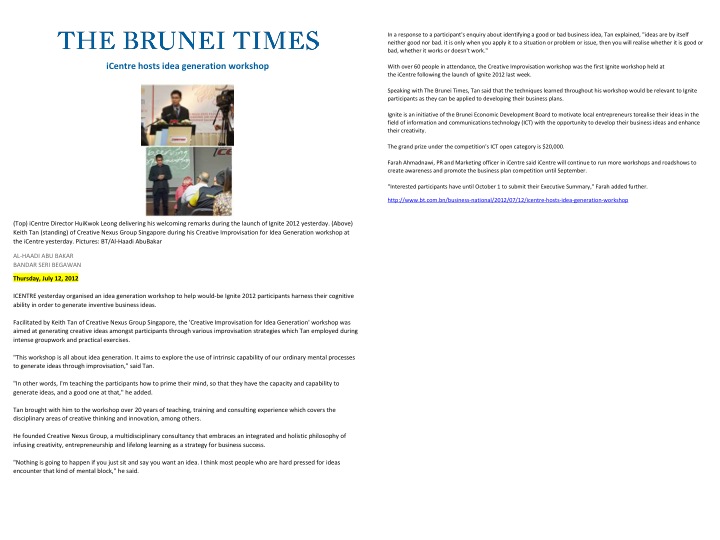
Human Resources Magazine, January 2012 Issue
Time To Change How We Think
The pace of change in business innovation in recent years has outstripped the rate of change in the way we work. Here are some ways to address this issue.
Technology may have enabled us to be more efficient and effective in our work, but we are still stuck in old patterns, routines and habits in the workplace. The business environment has been rapidly transformed by innovative changes but we have yet to re-define the way we work to embrace these changes to bring forth an equally rapid rise in the productivity of our work.
In the “cheaper, faster and better” paradigm of the business environment today, innovation-driven productivity is identified as the key driver for business and economic success.
What are the attitudes, skills and knowledge required to thrive in the rising complexity and uncertainty of the business environment?
This new business environment favours workers who are creative, insightful, intuitive, responsive to changes, adept at spotting opportunities and acting on them swiftly as they emerge.
Most importantly, it favours workers who are productive. To manifest these behaviours, the way we work must change.
To change the way we work, we need new ideas and to think better so we can re-define the way we work. We need to change the way we think about work to be more efficient and effective to increase productivity.
Productivity is not about routine. It is a discipline that needs to be fostered and embraced with an attitude change towards the way we think about work and the way we work. We need to create the change and to deal with it. The key questions are:
• How can we think differently about work and change the way we work to raise productivity?
• How can we drive productivity with effective thinking skills?
We need to foster design-thinking (this term refers to the methods and processes for investigating ill-defined problems, acquiring information, analysing knowledge and positing solutions) and interpret the multiple possibilities and perspectives of design-thinking to drive productivity.
This includes embracing the following characteristic design-thinking behaviours to increase productivity in the workplace:
1. Foster changes to the way we think about work, the way we work and the work process.
2. Think differently so that it matters less what we know and more how we think.
3. Look at problems and convert them into opportunities.
4. Generate ideas and solve problems effectively.
5. Think creatively and apply critical thinking skills.
6. Do less and achieve more.
Design-thinking plays a pivotal role in increasing productivity because it re- defines the future of work by creating meaningful work experiences.
It enables us to generate new ideas and effect changes for innovative breakthroughs. It gears us to meet the challenges of change. It breeds creativity and thrives best in environments that need change. In business, design thinking is applied to achieve growth through envisioning and developing new products and services to meet the challenges of the fast changing marketplaces.
New business processes are created because design-thinking enables businesses to see the business world from broad and different perspectives.
These are changes that come from new ideas that result from a better way of thinking.
The ideas also bring changes to the way we think about business, the way we think about work, and the way we work.
Workers in the new business environment must develop the essential thinking skills of creativity and critical evaluation that enable them to question assumptions, challenge conventions, ask good questions, think critically and intuitively, generate ideas, solve problems, seek alternative ways of doing things and create new possibilities to get work done in a productive way.
To address these needs, workers need appropriate training to gain a competitive advantage for employment, in particular training courses that equip them with the following competencies:
1. Able to develop personal strategies and approaches to use thinking skills effectively to increase productivity.
2. Respond to situations with purposeful and reflective judgment to determine course of action to drive productivity.
3. Break down complex problems into simpler parts and resolve them rationally.
4. Generate new ideas and concepts for effective resolution of issues and problems.
5. Develop a personal framework for design-thinking strategies for their professional roles and functions in an organisation.
The future of work can only be created if we imagine. The future of work should be a meaningful experience that we create to sustain innovation-driven productivity.
This can only come forth from our mind when it embraces design-thinking to think better and create meaningful work.
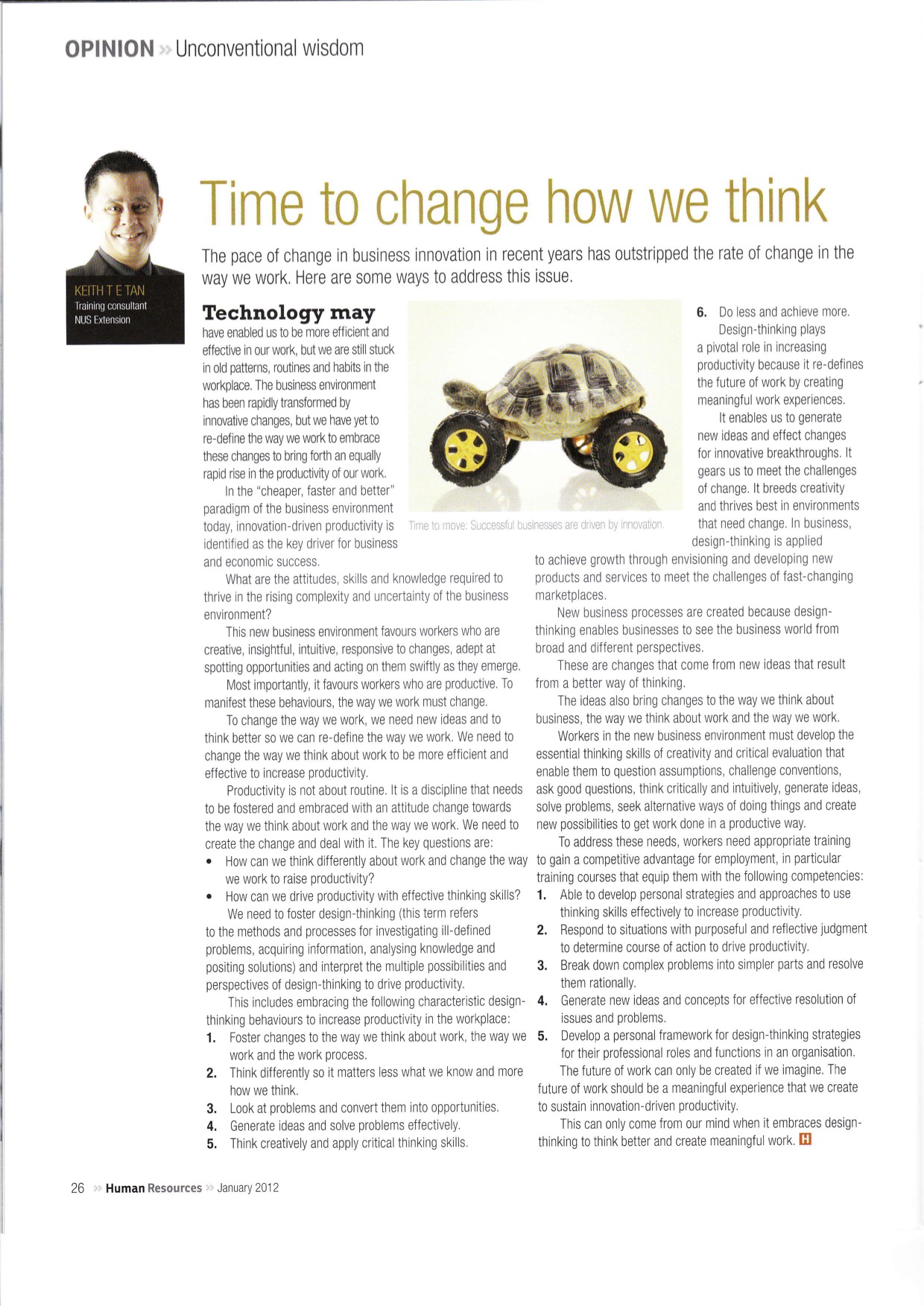
The Straits Times, 12 March 2011
Put on your creative thinking hat
Employers and employees need to invest in design thinking for the new business paradigm
CATS Recruit in The Straits Times - March 12, 2011
The rapidly evolving business environment of the world today has triggered sweeping changes to the way businesses are managed.
Companies around the world are placing greater emphasis on innovation than ever before.
A new generation of individuals is now needed to support a new business paradigm.
This new business paradigm embraces design thinking as a driving force to deliver innovation, to enhance creativity and productivity.
Organisations that recognise and adopt this new business paradigm are re-thinking their business models.
Traditional strategic business approaches of adapting an existing business model are on the brink of obsolescence.
Management are now adding value to their business by re-thinking the entire process — from shaving costs, adding new revenue streams and offering product services to creating brand promise, re-inventing existing product lines and creating a thematically desirable continuum of new products.
Design is placed at the core of a business strategy.
Employees’ new challenges
What can employees of today do to keep up?
How can they think better and add value to what they are doing as an investment for the future?
To be prepared to confront the new challenges in the new business paradigm, employees must now develop design thinking as a core competency.
They should understand the following:
What is design?
Design today has the influence to change organisational culture and practice.
It can help companies to change their organisational process to better understand what their customers need, and prompt them to create experiences that consumers yearn for or to fuel customers’ desires.
The role of design in a creative organisation
Today, design is no longer associated with merely dealing with product aesthetics.
The role of design has become strategic, and its functions in creative organisations have become critical to their success in innovation.
Design has extended its influence into the realm of product services, from which product service systems are developed to enhance productivity.
The strategic function of design
Design is a value-add process and product that can be used as a strategic tool for product branding and innovation to create competitive advantage for business success.
How designers think
In the new business paradigm, employees are expected to think like designers, approaching problems creatively.
This involves embracing creative thinking approaches to map out novel strategies to overcome business challenges, experimenting with new approaches to generate new ideas and testing ideas that have not been previously considered.
It can also include accepting failure as part of the process and learning from the experience.
How to embrace design thinking as a framework to generate creative ideas
Design has become the management skill of the future as design embodies the creative thinking process for delivering innovation.
Design thinking provides the framework to seek new meaning and alternative ways of seeing and thinking to inspire the generation of creative ideas and concepts.
How to use the mental tools of design thinking
These will help employees solve problems creatively and to address issues and conflicts in business challenges.
Cognitive processes that affect our thinking behaviour — that is, unleash creative thinking capabilities — include creative visualisation, creative improvisation and visual thinking.
Characteristics of the creative
People who engage in design thinking have the following characteristics:
Their minds are open to new possibilities;
They constantly ask good questions;
They question convention;
They take chances;
They try new approaches to doing things;
They experiment with novel ideas to generate alternative potential solutions to a problem;
They solve problems creatively; and
They thrive on diverse insights from a wide perspective of the real world.
Creative employees are assets to any business organisation that desires to go beyond the known and established boundaries, to trust intuition to advance into new frontiers and territories.
These individuals cultivate creativity, embrace creative thinking behaviour and develop the talent of communicating with visual narratives.
These are skill sets of and for the future, and creative employees will thrive in the new business landscape.
Article by Keith T. E. Tan, a training consultant with NUS Extension, which conducts courses on design thinking. For details on courses, call NUS Extension on 6333-8400 or visit www.nus.edu.sg/nex/
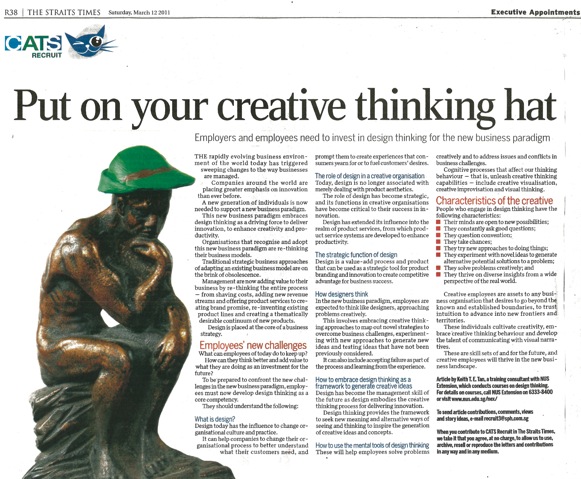
Keith Tan on 'Teaching, Learning and Creativity'
An Interview for Academic Research Paper by Lance Lim, Bachelor of Design Programme, UNSW College of Fine Arts, October 2008
Excerpt
"...if I were to be teaching you how to tie shoelaces and you carried out the task accordingly, you were merely following instructions and that made me a mere instructor. However, if I expected you to understand how and why you tied the shoelace before you would actually execute the task, you would have been made to think beyond the task; you were expected to understand before you acted. You could manipulate your understanding, re-interpret what to you was the means to get the shoelaces tied, and how much more fun you could have the shoelaces tied up if only you would not follow my instructions and you did it the way you wanted, and yet you had the task done. Then you were beginning to think creatively..."
Quote
"You can challenge conventions but you cannot defy logic."
